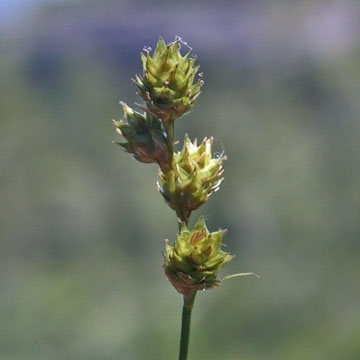

Carex brevior - (image 1 of 2)
Taxonomy
Family: Cyperaceae
Section Ovales
Habitat
Dry soil, usually in open habitats in calcareous soil.
Associates
Distribution
Quebec to VA, west to the Pacific.
Morphology
Tufted perennial, 20-100 cm, aphyllopodic; leaves firm, 2-4 mm wide, much shorter than stems; spikes mostly 3-6, gynaecandrous, stout, sessile, greenish-stramineous to light brown; bracts inconspicuous, shorter than the inflorescence; pistillate scales hyaline-scarious, with a firmer, often greenish midrib, narrower and tending to be shorter than the perigynia; perigynia crowded, stiffly ascending, 3.2-4.8 mm long, 1.3-1.7 times as long as wide, the body flattened, suborbicular, nearly nerveless ventrally, wing-margined all around and serrulate distally, abruptly contracted to the flattened, serrulate beak 0.8-1.5 mm; achene lenticular.
Notes
Fruiting June to August
Wetland indicator: FAC
This species is similar to C. molesta but the body of the perigynium is widest just below the middle (vs. widest about the middle) and nearly nerveless ventrally (vs. distinctly veined ventrally).
References
Gleason, Henry A. and A. Cronquist. 1991. Manual of Vascular Plants of
Northeastern United States and Adjacent Canada. Second Ed.
The New York Botanical Garden. Bronx, NY
|
© Michael Hough 2018 |